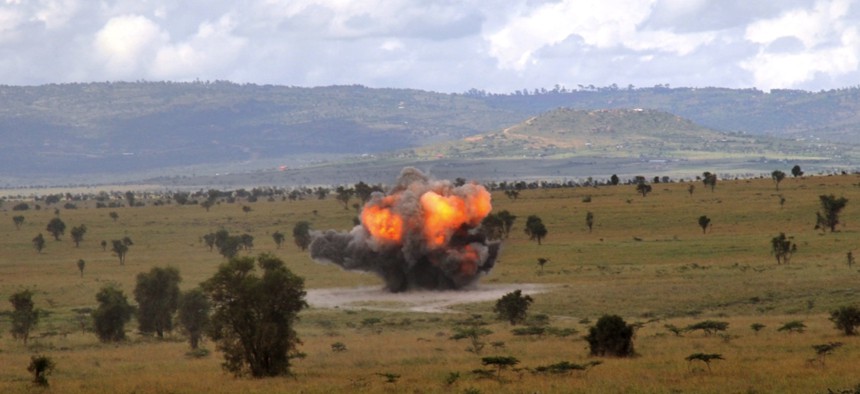
Kenyan Army explosive ordnance disposal (EOD) trainees detonate ordnance outside Nairobi, Kenya, during land-mine training conducted with U.S. Combined Joint Task Force - Horn of Africa. USAF / Staff Sergeant R.J. Biermann
The US Has Abandoned Its Leadership on Land Mines, and For What?
Defense Secretary Mark Esper says new land mines are needed to “ensure mission success” and “reduce risk to our forces.” What success? What forces?
The Cold War’s last battles—in Afghanistan, Latin America, southern Africa, and southeast Asia —claimed new victims long after the fighting ended. Land mines recklessly strewn over fields, hills, and along rivers continued to explode, tearing off limbs and ending innocent lives. In the first years of the new world order, the victims’ voices were finally heard — and Washington became a leader in the global effort to prevent a new generation of victims.
In 1992, President George H.W. Bush signed into law the Landmine Moratorium Act. It established a ban on the manufacturing, sale, and export of anti-personnel Land mines and pledged that the United States would seek verifiable international agreements “to ban forever the hidden killers.” And indeed, recent Iraq War had demonstrated that a highly mobile force could quickly sweep aside Saddam Hussein’s celebrated nine million land mines.
The following year, the U.S. Senate unanimously voted to extend the moratorium; at the United Nations, President Bill Clinton called for international negotiations on a broader set of limits. Elsewhere in New York, the International Campaign to Ban Land Mines was established through the efforts of Bobby Muller, of the Vietnam Veterans of America Foundation, and others. Prominent military officials such as Robert Gard — a retired lieutenant general, former National Defense University president, and Vietnam veteran — and James Hollingsworth, a former commander of U.S. forces in Korea, argued that the human cost of anti-personnel land mines far exceeded any military argument for their use.
This growing effort culminated in 1997, when the Canadian government convened government officials, NGOs, and experts in Ottawa to negotiate a historic agreement to ban the sale, export, and use of land mines.
Related: US Expected to Loosen Restrictions on Land Mines — Smart Ones, Anyway
But when 121 states signed this Ottawa Treaty, the United States was not among them.
Senior U.S. military leaders blocked the American signature of the treaty, arguing that land mines were necessary in the unique situation in the Korean Peninsula. We Canadians who had worked with the U.S. administration in forging this historic agreement were deeply disappointed by the last-minute retreat. But those of us active in the landmine campaign believed that the United States would observe the principal aims of the Treaty. And it did.
Through successive presidencies, the United States was a most generous funder of assistance for efforts to remove land mines and help their victims. Moreover, it neither produced nor exported mines. In 2014, President Barack Obama acknowledged the continuing American commitment to the humanitarian principles of the Ottawa Treaty and announced steps for the United States to become fully compliant. He called on the Defense Department to undertake a “high-fidelity modeling-and-simulation effort” to find a way to eliminate American use of land mines.
Regrettably, this positive record of leadership by successive administrations has been aborted by President Donald Trump. With the prodding of defense industry lobbyists, the Defense Department has constructed an argument for repudiation of the Ottawa principles, of President Obama’s initiative, and of the 164 states that have committed themselves to a ban on an indiscriminate killer of soldiers and citizens alike.
As the Trump administration takes a wrecking ball to multilateral institutions and agreements that have made the world a safer place, Defense Secretary Mark Esper has announced that the United States now needs to “ensure mission success and in order to reduce risk to our forces.”
What success? What forces? In 2017, 87 percent of 5,183 recorded land mine deaths were civilians, 2,452 children.
We are deeply proud of the Ottawa Treaty and profoundly thankful for the many Americans who gave leadership in its great achievements. Thirty-one mine-infested nations now have no hidden killers,” tens of millions of mines have been destroyed, and hundreds of thousands of our fellow human beings are not maimed or dead because of those promises made in Ottawa and, in Washington, by previous American administrations.
As the world now darkens, land mine casualties are soaring again in Afghanistan, Syria, Yemen, Ukraine and elsewhere as private and governmental arms dealers covertly undermine the treaty. Secretary Esper has recklessly supported these destructive forces. Rogue combatants around the world will regard his announcement as a license, and major powers such as Russia and China will feel free to amend their own no-use policies. We admired American leadership on land mines that once helped to draw us out of darkness. We despair as this administration dims that light.




